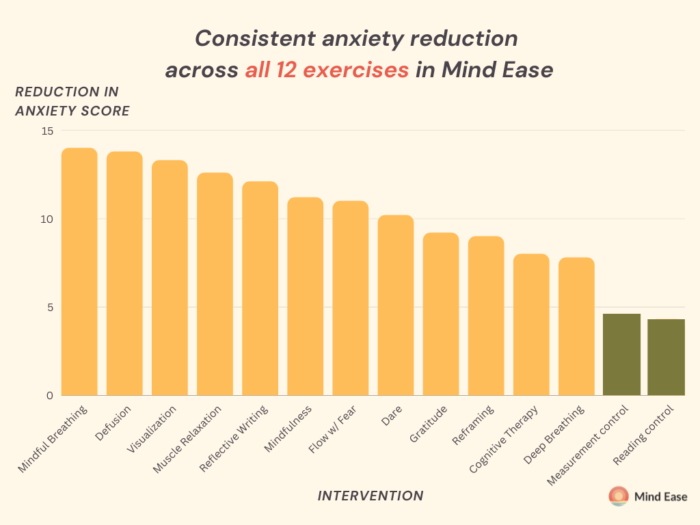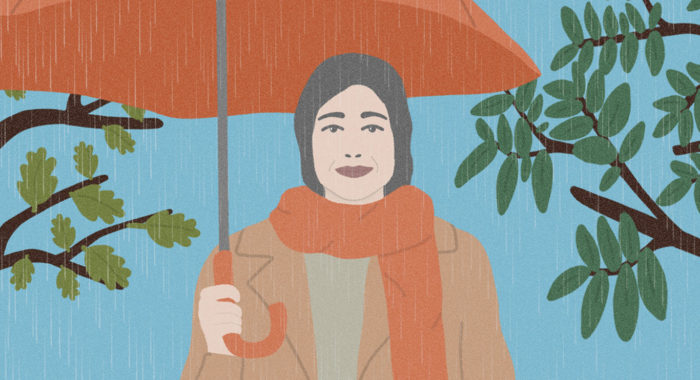Beyond Anecdotes: The RCT that Puts Mind Ease at the Forefront of Mental Wellbeing
Groundbreaking results from a recent randomized controlled trial put Mind Ease at the pinnacle of mental health apps.
In today’s fast-paced world, anxiety has become one of the most common psychological challenges many of us face. But, what if there was a scientifically-backed tool right at your fingertips to help manage it?
We always thought of Mind Ease as an evidence-based, science-driven app that offered relief from anxiety only using proven therapeutic techniques. What if it turned out it wasn’t the case?
The time has come to put the product to a real test. No more pilot studies, regular user testing, small trials with control groups. We reached out to a team of independent experts from renowned institutions like the University of Oxford and the University of Hamburg-Eppendorf, and embarked on a rigorous study to evaluate just how effective Mind Ease truly is.
Did we pass? Well, in the spirit of scientific transparency, we’d have let you know even if we didn’t. But, judging by the excited tone of this first paragraph, you can guess that the results are pretty exciting!
The Power of the MindEase App
Mind Ease isn’t just another app in the vast digital ocean of anxiety games, mindfulness apps, and sleep optimising tools. It’s a harmonious blend of strategies rooted in cognitive behavioural therapy, mindfulness, and acceptance and commitment therapy. These aren’t just buzzwords; they’re therapeutic techniques with a solid reputation for managing anxiety.
But, what happens when these strategies are translated into a digital format?
As a team that prides itself in an evidence-based approach we’ve been investigating this question since the inception of Mind Ease. All of Mind Ease’s exercises have been tested in studies and have shown positive results.
But, the golden standard of scientific research is an RCT, a randomized controlled trial. Most apps are not tested this way, and no wonder! It’s a process that takes months to plan, and months to execute, especially if you want to find independent researchers willing to carry it out. (Removing ourselves from the testing process was essential to make it unbiased!)
Most mental health apps are not tested using randomised controlled trials. Mind Ease is.
We take our mission of delivering effective mental health support seriously and put ourselves to the real test.
It wasn’t a small-scale survey, but a parallel, double-blind, randomized, placebo-controlled trial with 1108 participants. That’s a mouthful, but in simpler terms, we left no stone unturned to ensure our research was both thorough and unbiased.
What did we find?
Key Findings: How Mind Ease Makes a Difference
The numbers speak for themselves. The exercises in Mind Ease didn’t just make a small dent; they made a significant impact in reducing anxiety compared to other control methods.
Specifically, the mean efficacy of the exercises surpassed that of the control conditions with a notable effect size (η^2 = 0.063, d = 0.8 for reading control and η^2 = 0.059, d = 0.8 for measurement-only control).
Now, you might be wondering, “What do these numbers — η^2 = 0.063, d = 0.8 — actually mean?”
In simple terms, these values represent the size of the effect the exercises had in reducing anxiety. The larger these numbers, the stronger the effect. To put it in perspective, an effect size (d) of 0.8 is considered large. This means that the exercises in the Mind Ease app had a substantial impact in alleviating anxiety compared to just reading about anxiety or doing regular activities.
This chart illustrates the results in an easy-to-read way.

On the left you have average anxiety scores of all the participants before the interventions.
On the right, there is an average reduction in anxiety experienced by those in the control groups and those who used Mind Ease. The effects experienced by those who used Mind Ease are 3x higher than those observed in the control groups!
Ok, you might say, all these numbers are impressive on paper, but what does it mean for me, in practice?
Let’s say coffee is an intervention to boost focus. Imagine you’re feeling drowsy. Using other interventions is like sipping a small coffee, and using Mind Ease would be like downing a triple espresso shot, instantly waking you up! Or, think of anxiety like a headache.
While other interventions might be like taking half a paracetamol, using Mind Ease is like taking a full dose, rapidly easing the pain.
This isn’t just a win for us; it’s a win for every individual seeking relief from anxiety. These results translate to real, tangible benefits.
Results visible across all exercises!
It’s not just one or two exercises that stood out.
Each individual exercise in the app was found to be significantly more effective than the control conditions.
That’s the level of consistency even we were surprised by!
To measure the impact of the exercises, we used the same three sliders we have in the Mind Ease app, where we ask the users to rate their feelings ( from “very bad,” “very worried,” and “very tense” to “very good,” “very calm,” and “very relaxed”). Participants slid the marker to best describe how they felt at that moment. The scores ranged from 0 (feeling completely at ease) to 100 (super anxious). They did the same after completing each exercise and we calculated the difference between these scores.
The chart below shows the average reduction in anxiety points for each of the 12 Mind Ease exercises investigated in the study.

This chart shows the average reduction in anxiety points that a person experienced after completing an exercise. On the left you have all Calm Me exercises in Mind Ease. The two bars on the right show the anxiety reduction experienced by the control groups.
It’s important to note that these results were observed after a completing an exercise one single time. A longer, more regular use of Mind Ease can result in different levels of improvement, very likely higher!
Dive into the Exercises: What’s in it for me?
If you haven’t used Mind Ease before, the techniques on the chart above might be new to you. Let’s briefly zoom in on a few of them.

Reframing: This exercise is all about positive reappraisal. Instead of getting bogged down by negative thoughts, it encourages users to reinterpret situations by identifying their positive aspects.
Imagine you’re stuck in traffic and running late for an appointment. Instead of stressing about the delay, Reframing can help you see this as an opportunity to listen to a podcast or enjoy some quiet time. Next time you face a setback, use this exercise to find a silver lining.
Mindful Breathing: A cornerstone of mindfulness, this exercise is about anchoring yourself in the present. By focusing on each breath, it helps push anxiety to the background.
Let’s say you’re about to enter a job interview or take an important exam. Your heart’s racing, and your palms are sweaty. Just a few minutes of Mindful Breathing can help calm your nerves, center your thoughts, and prepare you to face the challenge head-on.

Calming Visualization: Ever wished you could escape to a serene beach or a quiet mountain top when things get too much? This exercise takes you on a mental journey to such relaxing environments, offering a brief respite from anxiety.
For example, after a hectic day at work or dealing with a stressful situation at home, take a moment to close your eyes and use Calming Visualization. Transport yourself to a peaceful place, be it a sunlit forest or a tranquil lakeside. It’s like a mini-vacation for your mind.
Dare Response: This exercise combines exposure and emotional reappraisal. It starts by helping users recognize the physical symptoms of anxiety. Then, it guides them to reframe these symptoms from anxiety (“I’m feeling anxious”) to excitement (“I’m feeling excited”).
Before a big presentation or a social gathering, you might feel those familiar butterflies in your stomach. Instead of dreading them, use the “Dare Response” to reinterpret that feeling. Tell yourself, “I’m not nervous; I’m excited!” This shift in perspective can transform your entire experience.
The beauty of these exercises is that they’re not just based on feel-good principles.
They’re grounded in rigorous scientific research. The way we translated them into an app format in Mind Ease reliably brings positive results for people with anxiety.
Taking Control of Your Mental Well-being
The journey of understanding and managing anxiety is a personal one, but it’s also one that doesn’t have to be taken alone. The Mind Ease app, backed by rigorous scientific research, offers a beacon of hope.
With strategies rooted in cognitive behavioural therapy, mindfulness, and acceptance and commitment therapy, it’s a tool that’s both powerful and evidence-based.
But, here’s the beauty of it: while the science behind MindEase might sound complex, the app itself is incredibly user-friendly. It’s designed for everyone, whether you’re a seasoned meditation guru or someone just starting to explore the world of mental well-being.
We want to invite you to dive into the world of MindEase, explore its range of exercises, and take the first step towards a more peaceful and centered you. Experience the transformative power of evidence-based relaxation and mindfulness exercises for yourself.
The research team is in the process of submitting the results of the RCT for publication in an academic journal. We will let you know when the article is available online!




